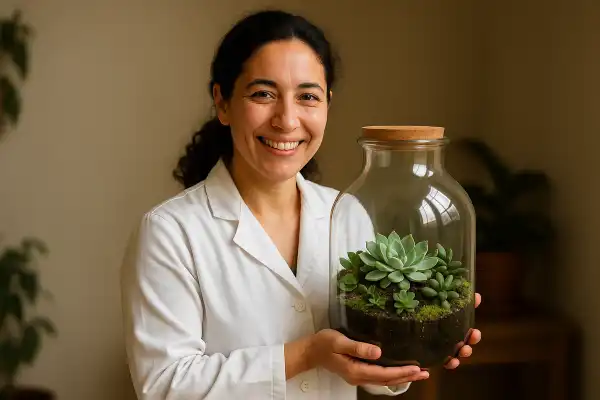Many plant enthusiasts ask “how to keep a terrarium alive?” because these miniature ecosystems can seem deceptively simple, yet they often struggle with mysterious plant deaths, mold outbreaks, or glass that’s perpetually fogged. The appeal of a self-sustaining garden under glass draws us in, but the reality requires understanding the delicate balance these micro-environments demand.
Terrariums represent nature’s most efficient closed-loop systems, where every element—from moisture cycles to plant selection—must work in harmony. When I first encountered a failing terrarium at university, watching its once-vibrant moss turn brown despite what seemed like perfect care, I realized these glass worlds teach us patience and precision in ways few other plants can.
How to keep a terrarium alive?
The key to keeping a terrarium alive lies in achieving the perfect balance of light, moisture, and airflow—when properly balanced, terrariums can pretty much look after themselves. Success comes from understanding that your terrarium is essentially a tiny greenhouse ecosystem that requires minimal but precise intervention.

Understanding your terrarium’s water cycle
The most critical aspect of terrarium care is monitoring condensation levels, which indicate whether your water cycle is functioning properly. A healthy closed terrarium should show condensation on one side of the glass about once daily, typically forming in the evening when humidity rises as plants produce oxygen.
You should be able to see condensation up to a third of the height of the jar—if you can see this, you don’t need to do anything as the terrarium will maintain an even level of humidity and become ‘self-watering’. This natural cycle eliminates the need for frequent watering that kills so many terrariums.
If heavy condensation persists throughout the day, creating water streaks down the glass or fog so thick your plants aren’t visible, this signals overwatering. Leave the terrarium open for a few days to let excess water evaporate and wipe up excess condensation with a paper towel.
Providing proper lighting conditions
Place your terrarium 1 meter from a north-facing window, 3 meters from an east or west-facing window, and 5 meters from a south-facing one. The glass acts as a magnifier, making direct sunlight potentially lethal to your plants through overheating.
Most tropical plants need bright indirect light—something you could comfortably read a book in but wouldn’t feel warmth on your skin, with 200 footcandles considered the bare minimum. Plants receiving insufficient light cannot photosynthesize properly, weakening them and making them susceptible to disease.
Preventing and managing mold growth
High humidity levels make perfect conditions for molds and fungi, especially if terrariums are overcrowded, but mold doesn’t affect healthy plants and is more of a nuisance than a serious threat. Mold typically appears as white, fuzzy patches on soil surfaces or decaying organic matter.
Remove any visible patches of mold using tweezers or a spoon, then figure out why the mold is growing to prevent it returning. Common causes include overwatering, poor-quality soil containing bark chips unsuitable for humid environments, or decorative elements that aren’t waterproof.
Open your terrarium for a day to reduce humidity, and consider introducing springtails—tiny insects that feed on fungi and help maintain ecosystem balance. Adding a thin layer of activated charcoal at the base also absorbs odors and excess moisture.
Selecting appropriate plants and maintaining them
Succulents generally thrive in high light and low humidity environments, so if you plant succulents in a closed terrarium, the climate is too humid for them to succeed. Stick to humidity-loving plants like ferns, mosses, and nerve plants (Fittonia) for closed systems.
Remove dead or dying plant material immediately using small, sharp scissors to prevent decay that can harbor mold spores. Most terrarium plants don’t need fertilizer—you want to inhibit growth to prevent overcrowding rather than encourage it.
Establishing the settling-in period
Give your terrarium a two-week incubation period, taking the cork off occasionally for the first two weeks as plants adjust to their new sealed environment. During this period, keep the terrarium at comfortable room temperature—at least 16°C—and monitor daily for changes.
Your terrarium will need to settle into its new home, and things don’t always go as planned, but patience during this period prevents major issues later. Some moss may brown or plants may show stress, but this often resolves as the ecosystem stabilizes.
Watering techniques and frequency
An established terrarium only needs watering every 2-3 months, and closed terrariums may need water just once a month on average. Use a spray bottle instead of a watering can to prevent over-watering, and if you do over-water, absorb extra water with a paper towel.
Only introduce water as vapor using a spray bottle or mister, as pouring water directly usually leads to an over-watered ‘swampy’ terrarium. Water only when you see no condensation on the glass for an entire day.
Maintaining glass clarity and cleanliness
Clean the glass inside and out periodically—if the glass is too dirty or foggy, it will be difficult for light to reach your plants. Use distilled water to avoid mineral deposits that create white streaks.
For curved glass, use paper towels or a clean rag, and for algae growth indicating too much light exposure, use an aquarium scraper or old credit card on flat surfaces. Avoid harsh cleaning products inside the terrarium that could harm plants.
Conclusion
Last month, when I checked on my six-year-old closed moss terrarium—the one that started my passion for these miniature worlds—I found it thriving with barely any intervention over the past year. Its self-sustaining cycle reminded me why I fell in love with terrarium building in the first place. This article represents the accumulated knowledge from countless glass gardens I’ve nurtured, failed with, and learned from throughout my journey as both a botanist and terrarium enthusiast.
El Castor is your exclusive terrarium guide.

